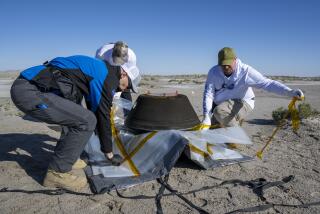Meteorites are linked to lone asteroid
- Share via
The first dust samples ever retrieved from an asteroid and brought back for study show that a portion of the most common meteorites to hit Earth may have come from a single rocky ancestor in space, Japanese researchers say.
In a wide-ranging analysis of tiny fragments collected from the asteroid Itokawa during a spacecraft visit in 2005, six studies by several teams of scientists released Thursday by the journal Science piece together a detailed description, and history, of this particular space rock.
The more than 1,500 dust grains gathered by Japan’s Hayabusa spacecraft -- which are uncontaminated by our atmosphere -- show that meteorites contain the primitive elements that formed the early solar system.
That knowledge, and study of the grains, will allow scientists to better understand what our part of the Milky Way looked like billions of years ago when the ring of gas and dust surrounding the sun began to coalesce to form planets, asteroids and comets.
“These dust particles are the building blocks of the planets,” said Tomoki Nakamura, a planetary scientist at Tohoku University in Sendai, Japan, who is one of the studies’ lead authors.
The fact that Hayabusa returned any particles at all is a small miracle. Launched in 2003, the spacecraft was designed to shoot an impactor into the surface of the stony asteroid Itokawa and then collect dust kicked up by the collision.
The impactor failed to fire, but the mission scientists got the craft to at least touch the asteroid’s surface.
“They didn’t know whether they trapped any particles or not,” said Alexander Krot, a cosmochemist at the University of Hawaii at Manoa who was not involved in the study.
When the return capsule landed in southern Australia in 2010, researchers were relieved to find enough particles for years of study.
After dissecting the particles, scientists have pieced together what happened to Itokawa.
They estimate that the 500-meter-long Itokawa was once perhaps 20 kilometers long but was smashed to bits in earlier times.
A study looking at the shapes of the grains found that the asteroid was porous, with about a third empty space -- which means it was created when those fragments were pulled back by gravity to form a “rubble pile.”
Analysis by Nakamura’s team showed that the mineral chemistry of Itokawa, which is a silica-rich “S-type” asteroid, matched one particular class of meteorites found on Earth, called low-total-iron, low metal ordinary chondrites.
For all that Itokawa’s dust has revealed, Krot said, scientists are still looking for direct evidence on asteroids of a molecule crucial for life as we know it: water. NASA’s OSIRIS-REx mission, which in 2016 will start toward an asteroid that might bear water, could be the key.
--







